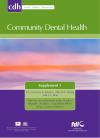Community Dental Health

- Cover Date:
- December 2008 (Supplement 1)
- Print ISSN:
- 0265 539X
- Vol:
- 25
- Issue:
- 4
Effective use of fluorides in the People’s Republic of China A model for WHO Mega Country initiatives
Poor dental health has been reported in the Chinese National Surveys of Oral Health. With the changing lifestyle and growing consumption of sugars, the incidence of dental caries may well continue to rise, compounded by limited access to professional care. The increasing oral disease burden could become a major public health problem in China, leading to considerable personal and health service costs. There is a desperate need for systematic implementation of preventive programmes. Currently, China is strengthening the prevention of chronic diseases, which provides an excellent opportunity to integrate oral disease prevention into the overall noncommunicable disease (NCD) prevention programmes. In order to address this growing public health problem, the World Health Organization (WHO) Global Oral Health Programme advocates the effective use of fluoride as an essential approach to prevent dental caries in the 21st century - part of the WHO Global Oral Health Strategy. Population-wide automatic fluoridation measures are considered the most effective, complemented by appropriate use of toothpastes containing fluoride. There are wide variations of fluoride levels in drinking water in China and, in many areas, the levels of fluoride in drinking water are lower than the recommended levels. The use of toothpaste containing fluoride is still too low in some areas and decreases with age. Those who live in rural areas have limited access to affordable toothpastes containing fluoride. In March 2006, as part of the WHO Mega Country Health Promotion Network initiatives, the WHO Global Oral Health Programme organised a three-day symposium in Beijing, People’s Republic of China. The aim of the symposium was to bring together international experience and Chinese expertise to facilitate policy development for effective use of fluoride in China, highlighting the benefits of, and barriers to, the implementation of different fluoridation programmes at the strategic levels as well as for operational planning. This article reports the proceedings of the meeting. In summary, China is a Mega country with much diversity and disparity. The situation in China is unique with endemic fluorosis due to other non-water sources of fluoride in some areas and a considerable dental caries burden in others. It is important to regulate the appropriate exposure to fluoride to obtain the benefits and avoid adverse effects of fluorides, controlling enamel fluorosis without jeopardising the prevention of dental caries. Various complementary fluoridation programmes can be considered for different population groups with varying needs, strategies that bring about additive effects. A multi-tier policy making approach at national, regional and provincial levels can be employed, based on sound evidence. The roles of WHO, Ministry of Health and the National Committee for Oral Health (NCOH) were emphasised. Lessons learned from the Chinese experience will prove invaluable to other countries with similar socio demographic characteristics that are in the same process of developing and implementing fluoridation policies and programmes.
Key words: Appropriate administration of fluorides, benefits and adverse effects of fluoride, Mega countries, national fluoride policy, population-directed prevention of dental caries, socio-environmental diversity
- Article Price
- £15.00
- Institution Article Price
- £
- Page Start
- 257
- Page End
- 267
- Authors
- P.E. Petersen, S. Kwan, L. Zhu, J.YB.X. Zhang, J.Y. Bian
Articles from this issue
- Title
- Pg. Start
- Pg. End
- Effective use of fluorides in the People’s Republic of China A model for WHO Mega Country initiatives
- 257
- 267
